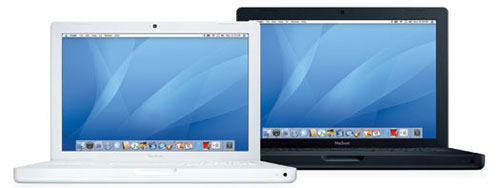Hosted by site sponsor WebMate.
White & Black MacBook Q&A - Revised November 11, 2006
To be notified of new Q&As, sign up for EveryMac.com's bimonthly email list.
How does the original MacBook compare to the iBook model it replaced?
Please note that all systems mentioned in this Q&A have been discontinued. The original MacBook was replaced by the "Late 2006" MacBook Core 2 Duo.
The original MacBook was actually a replacement for three models -- the PowerBook G4/1.5 12", iBook G4/1.33 12" (Mid-2005), and iBook G4/1.42 14" (Mid-2005) -- which makes comparison more complicated. Effectively, Apple decided to consolidate these three different notebooks that were sold in two "families", into a single line with a single form factor but two color choices and three configurations.

Photo Credit: Apple Computer
At first glance one might think the MacBook models look quite a bit like the late model iBook systems, as two of the MacBook models have white cases (the other one has a black case), but quickly notice the MacBook has a 13.3" widescreen TFT active-matrix "glossy" display compared to 12" or 14" matte displays for the replaced models. With a silver case, the PowerBook G4 12" immediately looks quite a bit different from the MacBook line.
One also will notice quickly that the MacBook has a built-in iSight video camera, an included Apple Remote for use with Apple Front Row software, the clever "MagSafe" power connector that magnetically disconnects if someone trips over the cord, a redesigned "flush against the bed" keyboard that does not touch the screen, and a "no moving parts" magnetic latch that "catches without a catch". None of these features are present in the iBook or PowerBook G4 models that the MacBook replaced.
Ports provided by the MacBook and the models it replaced are similar, but the MacBook inherits the mini-DVI out port from the "professional" PowerBook G4 model, and for the first time on a "consumer" Apple notebook, officially supports an external display. The MacBook also features Gigabit Ethernet and optical digital audio in/out, which neither the "consumer" iBook nor the "professional" PowerBook G4 12" models supported. However, the MacBook lacks an internal modem.
With even a quick review of the technical specifications of each model, however, it becomes immediately apparent that the MacBook is a completely different machine than the models it replaced. All models share the "Sudden Motion Sensor" technology that stops the hard drive heads from moving if the notebook is dropped, but that is about it.
The MacBook essentially has little, if anything, in common architecturally compared to the iBook and PowerBook G4. The original MacBook has an Intel "Core Duo" processor with two independent processor "cores" on a single silicon chip, a 2 MB shared "on chip" level 2 cache, a 667 MHz frontside bus, DDR2 SDRAM (PC2-5300) support, and an Intel GMA 950 integrated graphics processor. The iBook and PowerBook G4, on the other hand, have PowerPC processors, smaller level 2 caches, slower buses, and support for older PC2700 RAM, but have "dedicated" graphics from ATI (iBook) or NVIDIA (PowerBook G4).
Please refer to the Ultimate Mac Comparison feature to dynamically compare any MacBook model to any other G3 or later Mac.
Permalink | Report an Error/Typo | Sign Up for Site Update Notices
<< White & Black MacBook Q&A (Main)
Established in 1996, EveryMac.com has been created by experts with decades of experience with Apple hardware. EveryMac.com includes, and always has included, original research incorporating detailed, hands-on inspection of packaging, computers, and devices as well as extensive real-world use. All information is provided in good faith, but no website or person is perfect. Accordingly, EveryMac.com is provided "as is" without warranty of any kind whatsoever. EveryMac.com, and the authors thereof, shall not be held responsible or liable, under any circumstances, for any damages resulting from the use or inability to use the information within. For complete disclaimer and copyright information please read and understand the Terms of Use and the Privacy Policy before using EveryMac.com. Copying, scraping, or use of any content without expressed permission is not allowed, although links to any page are welcomed and appreciated.
